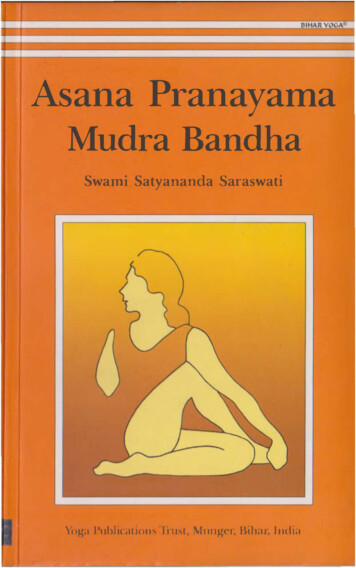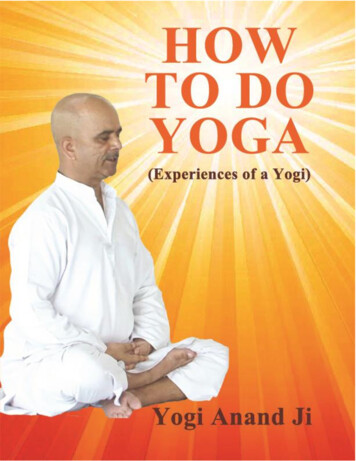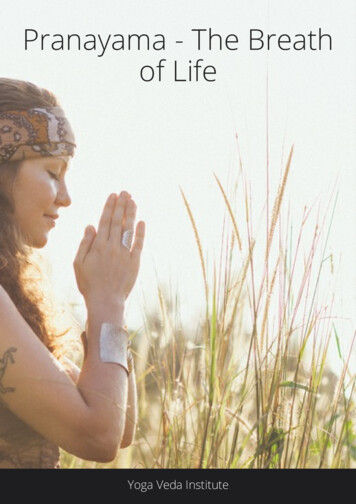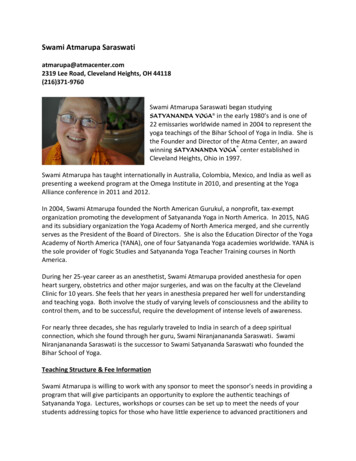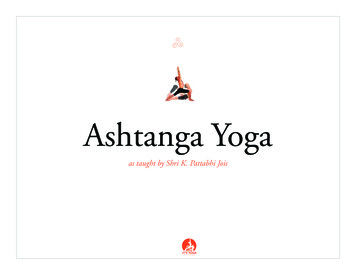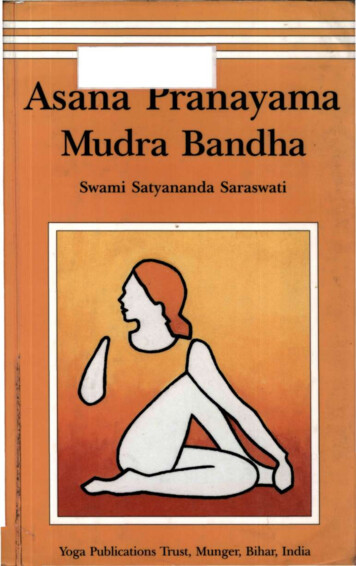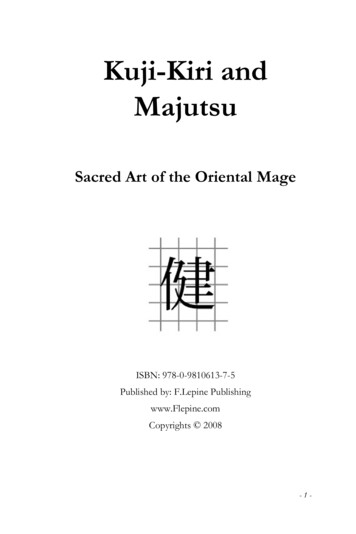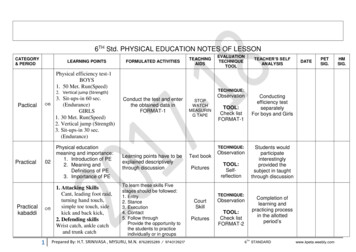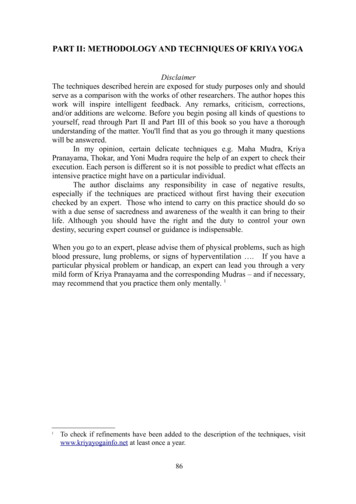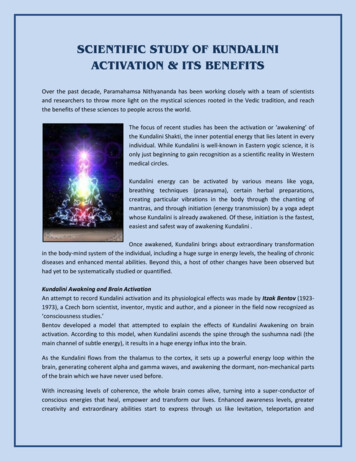
Transcription
Asana PranayamaMudra BandhaWith kind regards,and prem
Asana PranayamaMudra BandhaSwami Satyananda SaraswatiYoga Publications Trust, Munger, Bihar, India
YOGA PUBLICATIONS TRUSTAsana Pranayama Mudra BandhaAsana Pranayama Mudra Bandha is internationally recognized as one of the most systematic manualsof hatha yoga available. First published in 1969, it has been in print ever since. Translated into manylanguages, it is the main text of yoga teachers and students of BIHAR YOGA – SATYANANDA YOGA andnumerous other traditions.This comprehensive text provides clear illustrations and step by step instructions, benefits andcontra-indications to a wide range of hatha yoga practices, including the little-known shatkarmas(cleansing techniques). A guide to yogic physiology explains the location, qualities and role of thebody’s subtle energy system, composed of the pranas, nadis and chakras. Straightforwarddescriptions take the practitioner from the simplest to the most advanced practices of hatha yoga.Asana Pranayama Mudra Bandha is an essential text for all yoga aspirants.Swami Satyananda Saraswati founded the Bihar School of Yoga, India, in 1963. He interpreted theclassical practices of yoga and tantra for application in modern society, inspiring an internationalyoga movement for the upliftment of humanity.
Bihar School of Yoga 1969, 1973, 1996, 2008, 2015All rights reserved. No part of this publication may be reproduced, transmitted or stored in a retrieval system, in anyform or by any means, without permission in writing from Yoga Publications Trust.The terms Satyananda Yoga and Bihar Yoga are registered trademarks owned by International Yoga Fellowship Movement(IYFM). The use of the same in this book is with permission and should not in any way be taken as affecting the validity of themarks.The purpose of this book is to provide relevant information regarding yoga practice; it is not to be used for teachingoneself or others. All yoga training and learning should be done under the guidance of an experienced, competentteacher, not from the book alone.Published by Bihar School of YogaFirst edition 1969Reprinted 1971Second edition 1973Reprinted 1977, 1980, 1983, 1989, 1993, 1995, 1996Third (revised) edition 1996 (by Bihar Yoga Bharati with permission of Bihar School of Yoga)Reprinted 1997, 1999Published by Yoga Publications TrustReprinted 2002, 2004 (twice), 2005, 2006Fourth (revised) edition 2008Reprinted 2008, 2009, 2012, 2013First digital edition 2015ISBN (print): 978-81-86336-14-4ISBN eMOBI: 978-93-84753-26-9ISBN ePUB: 978-93-84753-27-6Publisher and distributor: Yoga Publications Trust, Ganga Darshan, Munger, Bihar, India.Website: www.biharyoga.net
DedicationIn humility we offer this dedication toSwami Sivananda Saraswati, who initiatedSwami Satyananda Saraswati into the secrets of yoga.
ContentsPrefaceIntroduction to YogaAsanaIntroduction to YogasanaBeginners GroupPawanmuktasana SeriesPart 1: Anti-rheumatic GroupPart 2: Digestive/Abdominal GroupPart 3: Shakti Bandha AsanasYoga Exercises for the EyesRelaxation AsanasMeditation AsanasVajrasana Group of AsanasStanding AsanasSurya NamaskaraChandra NamaskaraIntermediate GroupPadmasana Group of AsanasBackward Bending AsanasForward Bending AsanasSpinal Twisting AsanasInverted AsanasBalancing AsanasAdvanced GroupPranayamaMudraBandhaShatkarmaPsychic Physiology of YogaIndex of Practices
PrefaceT he first edition of Asana Pranayama Mudra Bandha, published in 1969, was derived from thedirect teaching of Swami Satyananda Saraswati during the nine month Teachers Training Courseconducted at Bihar School of Yoga, Munger, in 1969. The second edition was published in 1973 tocommemorate his Golden Jubilee Birthday. At this time, the text was completely revised and newmaterial was added from class notes taken during the 1970–71 Sannyasa Training Course, which wasthe last course that he personally conducted.In response to popular demand and to meet the requirements of a university text, APMB wasrevised and updated under the direction and inspiration of Swami Niranjanananda Saraswati, thesuccessor of Swami Satyananda Saraswati. This text is currently being used as the main practical textfor the teaching of asana, pranayama, mudra, bandha and shatkarma around the world by yogateachers from every tradition and path.Since publication of the first edition, interest in yoga has spread widely. Now APMB is used inashrams, centres and yoga schools in every country as the standard textbook for teachers andstudents alike. The techniques presented have been assimilated by fields as diverse as medicine,education, entertainment, business, sports and the training of spiritual aspirants.The science of yoga applies itself to all aspects of life. This revised edition presents basic yogicpractices including asanas , postures; pranayamas, breathing techniques; mudras, positions orgestures which represent the psyche; bandhas, locks for channelling energy; and shatkarmas,cleansing practices. All of these techniques purify the body, mind and energy systems to prepare theground for higher practices of meditation and for the ultimate experience of cosmic consciousness.Also included is a section introducing the chakras, psychic centres, and other aspects of the subtlebody.The effects of yogic practices during and after performance are currently being researched byscientists and doctors around the world. Their results show that asanas, pranayamas, mudras andbandhas are a potent means to restore and maintain physical and mental health.Asana Pranayama Mudra Bandha is designed for yoga students, spiritual seekers and for thosestudying yoga in depth. Although many health professionals consult this text as a guide whenconstructing programs to provide clients with physical, mental and emotional balance, thesetechniques are not primarily for the sick but for the healthy.When learning the practices of yoga, the guidance of a competent teacher is recommended. Peoplewith specific health problems or who are undergoing a period when extra care is needed, such aspregnancy, need individual guidance, not techniques learned from a book, not even this book. Thistext provides yogic practices and information for personal evolution. When practised faithfully, underthe guidance of a competent teacher, these techniques will expand your consciousness.Many sannyasins have selflessly contributed to the compiling, editing and publishing of this text. Toone and all, yoga aspirants extend their gratitude for bringing this information to them.
Introduction to YogaYoga is not an ancient myth buried in oblivion. It is the most valuable inheritance of thepresent. It is the essential need of today and the culture of tomorrow.—Swami Satyananda SaraswatiYoga is the science of right living and, as such, is intended to be incorporated in daily life. It works onall aspects of the person: the physical, vital, mental, emotional, psychic and spiritual.The word yoga means ‘unity’ or ‘oneness’ and is derived from the Sanskrit word yuj, which means‘to join’. This unity or joining is described in spiritual terms as the union of the individualconsciousness with the universal consciousness. On a more practical level, yoga is a means ofbalancing and harmonizing the body, mind and emotions. This is done through the practice of asana,pranayama, mudra, bandha, shatkarma and meditation, and must be achieved before union can takeplace with the higher reality.The science of yoga begins to work on the outermost aspect of the personality, the physical body,which for most people is a practical and familiar starting point. When imbalance is experienced at thislevel, the organs, muscles and nerves no longer function in harmony; rather they act in opposition toeach other. For instance, the endocrine system might become irregular and the efficiency of thenervous system decrease to such an extent that a disease will manifest. Yoga aims at bringing thedifferent bodily functions into perfect coordination so that they work for the good of the whole body.From the physical body, yoga moves on to the mental and emotional levels. Many people sufferfrom phobias and neuroses as a result of the stresses and interactions of everyday living. Yoga cannotprovide a cure for life, but it does present a proven method for coping with it.Swami Sivananda Saraswati of Rishikesh explained yoga as an “. . . integration and harmonybetween thought, feeling and deed, or integration between head, heart and hand”. Through thepractices of yoga, awareness develops of the interrelation between the emotional, mental andphysical levels, and how a disturbance in any one of these affects the others. Gradually, thisawareness leads to an understanding of the more subtle areas of existence.There are many branches of yoga: raja, hatha, jnana, karma, bhakti, mantra, kundalini and laya, toname but a few, and many texts explain them in detail. Each individual needs to find those yogas mostsuited to his or her particular personality and need. In the last half of the twentieth century, hathayoga had become the most well-known and widely practised of the systems. However, the concept ofwhat constitutes yoga is broadening as more people take it up, and this knowledge is spreading. Inthe ancient texts, hatha yoga consists of the shatkarmas, cleansing practices, only. Today, however,hatha yoga commonly embraces the practices of asana, pranayama, mudra and bandha as well.History of yogaThe yoga we know today was developed as a part of the tantric civilization which existed in India andall parts of the world more than ten thousand years ago. In archaeological excavations made in theIndus Valley at Harappa and Mohenjodaro, now in modern Pakistan, many statues have been founddepicting deities resembling Lord Shiva and Shakti (in the form of Parvati) performing various asanasand practising meditation. These ruins were once the dwelling place of people who lived in the prevedic age before the Aryan civilization started to flourish in the Indus subcontinent. According tomythical tradition, Shiva is said to be the founder of yoga, and Parvati, his first disciple.Lord Shiva is considered to be the symbol or embodiment of supreme consciousness. Parvatirepresents supreme knowledge, will and action, and is responsible for all creation. This force orenergy is also known as kundalini shakti, the cosmic force which lies dormant in all beings. Parvati isregarded as the mother of the whole universe. The individual soul is embodied and bound to the worldof name and form, and also liberated from the bondage of the world and united with supremeconsciousness through her grace. Out of love and compassion for her children, she imparted hersecret knowledge of liberation in the form of tantra. The techniques of yoga have their source intantra and the two cannot be separated, just as consciousness, Shiva, cannot be separated fromenergy, Shakti.Tantra is a combination of two words, tanoti and trayati, which mean ‘expansion’ and ‘liberation’respectively. Therefore, it is the science of expanding the consciousness and liberating the energy.Tantra is the way to attain freedom from the bondage of the world while still living in it. The first stepin tantra is to know the limitations and capacities of the body and mind. Next it prescribes techniquesfor the expansion of consciousness and the liberation of energy whereby individual limitations aretranscended and a higher reality experienced.Yoga arose at the beginning of human civilization when humankind first realized their spiritualpotential and began to evolve techniques to develop it. The yogic science was slowly developed byancient sages all over the world. The essence of yoga has often been shrouded in or explained by
different symbols, analogies and languages. Some traditions believe that yoga was a divine giftrevealed to the ancient sages so that humankind could have the opportunity to realize its divinenature.In ancient times, yoga techniques were kept secret and were never written down or exposed topublic view. They were passed on from teacher or guru to disciple by word of mouth. In this way therewas a clear understanding of their meaning and aim. Through personal experience, realized yogis andsages were able to guide sincere aspirants along the correct path, removing any confusion,misunderstanding and excessive intellectual contemplation.The first books to refer to yoga were the ancient Tantras and later the Vedas, which were writtenabout the time the Indus Valley culture was flourishing. Although they do not give specific practices,they allude to yoga symbolically. In fact, the verses of the Vedas were heard by the rishis, seers, instates of deep yogic meditation or samadhi , and are regarded as revealed scriptures. It is, however,in the Upanishads that yoga begins to take a more definable shape. These scriptures collectively formVedanta, the culmination of the Vedas, and are said to contain the essence of the Vedas.Sage Patanjali’s treatise on raja yoga, the Yoga Sutras, codified the first definitive, unified andcomprehensive system of yoga. Often called the eight-fold path, it is comprised of yama, selfrestraints, niyama , self-observances, asana, pranayama, pratyahara, disassociation of consciousnessfrom the outside environment, dharana, concentration, dhyana, meditation, and samadhi ,identification with pure consciousness.In the 6th century BC, Buddha’s influence brought the ideals of meditation, ethics and morality tothe fore and the preparatory practices of yoga were ignored. However, Indian thinkers soon realizedthe limitations of this view. The yogi Matsyendranath taught that before taking to the practices ofmeditation, the body and its elements need purifying. He founded the Nath cult and the yogic posematsyendrasana was named after him. His chief disciple, Gorakhnath, wrote books on hatha yoga inthe local dialect and in Hindi.Indian tradition previously required that original texts be written in Sanskrit. In some cases theyclothed their writings in symbolism so that only those qualified to receive a teaching would be able tounderstand it. One of the most outstanding authorities on hatha yoga, Swami Swatmarama, wrote theHatha Yoga Pradipika, or ‘Light on Yoga’, in Sanskrit, collating all extant material on the subject. Indoing so, he reduced the emphasis on yama and niyama, thereby eliminating a great obstacleexperienced by many beginners. In the Hatha Yoga Pradipika , Swatmarama starts with the body andonly later, when the mind has become stable and balanced, are the yamas and niyamas (self-controland self-discipline) introduced.The relevance of yoga todayToday, in the 21st century, a spiritual heritage is being reclaimed of which yoga is very much a part.While yoga’s central theme remains the highest goal of the spiritual path, yogic practices give directand tangible benefits to everyone regardless of their spiritual aims.Physical and mental cleansing and strengthening is one of yoga’s most important achievements.What makes it so powerful and effective is the fact that it works on the holistic principles of harmonyand unification. According to medical scientists, yoga therapy is successful because of the balancecreated in the nervous and endocrine systems which directly influences all the other systems andorgans of the body.For most people in the 20th century, yoga was simply a means of maintaining health and wellbeingin an increasingly stressful society. Asanas do remove the physical discomfort accumulated during aday at the office sitting in a chair, hunched over a desk. Relaxation techniques help to maximize theeffectiveness of ever-diminishing time off. In an age of mobile phones, internet and twenty-four hourshopping, yogic practices make great personal and even business sense.In the 21st century, beyond the needs of individuals, the underlying principles of yoga provide areal tool to combat social malaise. At a time when the world seems to be at a loss, rejecting pastvalues without being able to establish new ones, yoga provides a means for people to find their ownway of connecting with their true selves. Through this connection with their real selves, it is possiblefor people to manifest harmony in the current age, and for compassion to emerge where hithertothere has been none.In this respect, yoga is far from simply being physical exercises. It is an aid to establishing a newperception of what is real, what is necessary, and how to become established in a way of life whichembraces both inner and outer realities. This way of life is an experience which cannot be understoodintellectually and will only become living knowledge through practice and experience. However, therenaissance has begun.
Asana
Hathasya prathamaangatvaadaasanam poorvamuchyate.Kuryaattadaasanam sthairyamaarogyam chaangalaaghavam.Prior to everything, asana is spoken of as the first part of hatha yoga.Having done asana, one attains steadiness of body and mind, freedom from disease andlightness of the limbs.Hatha Yoga PradipikaAsana means a state of being in which one can remain physically and mentally steady, calm,quiet and comfortable. In the Yoga Sutras of Patanjali there is a concise definition ofyogasanas: “Sthiram sukham aasanam”, meaning that position which is comfortable andsteady. So, we can see that yogasanas in this context are practised to develop the practitioner’sability to sit comfortably in one position for an extended length of time, as is necessary duringmeditation.In raja yoga, asana refers to the sitting position, but in hatha yoga it means somethingmore. Asanas are specific body positions which open the energy channels and psychic centres.They are tools to higher awareness and provide the stable foundation for our exploration of thebody, breath, mind and beyond. The hatha yogis also found that by developing control of thebody through asana, the mind is also controlled. Therefore, the practice of asana is foremost inhatha yoga.
Introduction to YogasanaI n the Yoga Sutras of Patanjali there is a concise definition of yogasana: “Sthiram sukham aasanam”,meaning ‘that position which is comfortable and steady’. In this context, asanas are practised todevelop the ability to sit comfortably in one position for an extended period of time, an abilitynecessary for meditation. Raja yoga equates yogasana to the stable sitting position.The hatha yogis, however, found that certain specific body positions, asanas, open the energychannels and psychic centres. They found that developing control of the body through these practicesenabled them to control the mind and energy. Yogasanas became tools to higher awareness, providingthe stable foundation necessary for the exploration of the body, breath, mind and higher states. Forthis reason, asana practice comes first in hatha yoga texts such as Hatha Yoga Pradipika.In the yogic scriptures it is said that there were originally 8,400,000 asanas, which represent the8,400,000 incarnations every individual must pass through before attaining liberation from the cycleof birth and death. These asanas represented a progressive evolution from the simplest form of life tothe most complex: that of a fully realized human being. Down through the ages the great rishis andyogis modified and reduced the number of asanas to the few hundred known today. Of these fewhundred, only the eighty-four most useful are discussed in detail. Through their practice, it is possibleto side-step the karmic process and bypass many evolutionary stages in one lifetime.Animal posturesMany of the yogasanas described in this book are named after and reflect the movements of animals.Through observation, the rishis understood how animals live in harmony with their environment andwith their own bodies. They understood, through experience, the effects of a particular posture andhow the hormonal secretions could be stimulated and controlled by it. For example, by imitating therabbit or hare in shashankasana they could influence the flow of adrenaline responsible for the ‘fightor flight’ mechanism. Through imitating animal postures, the rishis found they could maintain healthand meet the challenges of nature for themselves.Yogasanas and pranaPrana, vital energy, which corresponds to ki or chi in Chinese medicine, pervades the whole body,following flow patterns, called nadis, which are responsible for maintaining all individual cellularactivity. Stiffness of the body is due to blocked prana and a subsequent accumulation of toxins. Whenprana begins to flow, the toxins are removed from the system, ensuring the health of the whole body.As the body becomes supple, postures which seemed impossible become easy to perform, andsteadiness and grace of movement develop. When the quantum of prana is increased to a greatdegree, the body moves into certain postures by itself and asanas, mudras and pranayamas occurspontaneously.Yogasanas and kundaliniThe ultimate purpose of yoga is the awakening of kundalini shakti, the evolutionary energy in man.Practising asanas stimulates the chakras, distributing the generated energy of kundalini all over thebody. About thirty-five asanas are specifically geared to this purpose: chakrasana for manipurachakra, sarvangasana for vishuddhi, sirshasana for sahasrara and so on. The other asanas regulateand purify the nadis, facilitating the conduction of prana throughout the body. The main object ofhatha yoga is to create balance between the interacting activities and processes of the pranic andmental forces. Once this has been achieved, the impulses generated give a call of awakening tosushumna nadi, the central pathway in the spine, through which the kundalini energy ascends tosahasrara chakra, thereby illumining the higher centres of human consciousness.Hatha yoga, therefore, not only strengthens the body and improves health, but also activates andawakens the higher centres responsible for the evolution of human consciousness.Yogasanas and the body-mind connectionThe mind and body are not separate entities, although there is a tendency to think and act as thoughthey are. The gross form of the mind is the body and the subtle form of the body is the mind. Thepractice of asana integrates and harmonizes the two. Both the body and the mind harbour tensions orknots. Every mental knot has a corresponding physical, muscular knot and vice versa.The aim of asana is to release these knots. Asanas release mental tensions by dealing with them onthe physical level, acting somato-psychically, through the body to the mind. For example, emotionaltensions and suppression can tighten up and block the smooth functioning of the lungs, diaphragm
and breathing process, contributing to debilitating illnesses in the form of respiratory disorders.Muscular knots can occur anywhere in the body: tightness of the neck as cervical spondylitis, theface as neuralgia, etc. A well chosen set of asanas, combined with pranayama, shatkarmas, meditationand yoga nidra, is most effective in eliminating these knots, tackling them from both the mental andphysical levels. The result is the release of dormant energy; the body becomes full of vitality andstrength, and the mind becomes light, creative, joyful and balanced.Regular practice of asana maintains the physical body in an optimum condition and promoteshealth even in an unhealthy body. Through asana practice, the dormant energy potential is releasedand experienced as increased confidence in all areas of life.Yogasana and exerciseYogasanas have often been thought of as a form of exercise. They are not exercises, but techniqueswhich place the physical body in positions that cultivate awareness, relaxation, concentration andmeditation. Part of this process is the development of good physical health by stretching, massagingand stimulating the pranic channels and internal organs, so asana is complementary to exercise.Before the difference between the two can be understood, it is necessary to know that exerciseimposes a beneficial stress on the body. Without it the muscles waste, the bones become weak, thecapacity to absorb oxygen decreases, insulin insensitivity can occur, and the ability to meet thephysical demands of sudden activity is lost.There are several differences in the way asana and exercise affect body mechanisms. Whenyogasanas are performed, respiration and metabolic rates slow down, the consumption of oxygen andthe body temperature drop. During exercise, however, the breath and metabolism speed up, oxygenconsumption rises, and the body gets hot. Yoga postures tend to arrest catabolism whereas exercisepromotes it. In addition, asanas are designed to have specific effects on the glands and internalorgans, and to alter electrochemical activity in the nervous system.Yogasanas classifiedThe asanas are classified into three groups: beginners, intermediate and advanced. It is not necessaryto perform all the asanas in a particular group. Regular practice of a balanced program, tailored toindividual needs, is recommended for maximum benefit.The beginners group should be performed by those who have never practised yogasanas before.Only a selection from this group, tailored to individual needs, should be practised by those who areinfirm in any way, weak or sick. They will give greater benefits than more difficult practices. Thisgroup consists of elementary techniques designed to prepare the body and mind for major andmeditation asanas. These practices are in no way inferior to the advanced asanas and are very usefulin improving physical health. Experienced practitioners in particular will notice the profound yetsubtle balancing effect. Included in this group are the pawanmuktasana series, eye exercises,relaxation, pre-meditation and meditation poses, asanas performed from vajrasana, standing asanas,surya and chandra namaskara.The intermediate group consists of asanas which are reasonably difficult and are recommended forpeople who can perform the beginners group without discomfort or strain. These asanas require agreater degree of steadiness, concentration and coordination with the breath. Included in this groupare asanas performed from padmasana, backward and forward bending, spinal twisting, inverted andbalancing asanas.The advanced group is intended for people with extensive control over their muscles and nervoussystem, who have already mastered the middle group of asanas. Practitioners should not be too eagerto start these asanas. It is preferable to practise them under the guidance of a competent teacher.Dynamic and static yogasanasDynamic practices often involve energetic movements of the body. They are intended to increaseflexibility, improve circulation, tone the muscles and joints, release energy blocks and removestagnant waste from different parts of the body. These asanas strengthen the lungs and improve thedigestive and excretory systems. Dynamic practices are particularly useful for beginners. Theyinclude the pawanmuktasana series, surya namaskara, chandra namaskara, dynamicpaschimottanasana and dynamic halasana.Static practices of intermediate and advanced asanas are performed by experienced practitioners.They have a more subtle and powerful effect on the pranic and mental bodies. They are performedwith little or no movement, the body often remaining in one position for a few minutes. These asanasare intended to gently massage the internal organs, glands and muscles as well as to relax the nervesthroughout the body. They are specifically concerned with bringing tranquillity to the mind andpreparing the practitioner for the higher practices of yoga, such as meditation. Some of them areparticularly useful for inducing the state of sense withdrawal, pratyahara.General notes for the practitionerThe following practice notes should be thoroughly understood before going any further. Althoughanybody can practise asanas, they become more efficacious and beneficial when performed in theproper manner after correct preparation.Breathing : Always breathe through the nose unless specific instructions are given to the contrary.
Coordinate the breath with the asana practice.Awareness : This is as essential to the practice of asana as it is to all yoga practices. The purpose ofasana practice is to influence, integrate and harmonize all the levels of being: physical, pranic,mental, emotional, psychic and spiritual. At first it may appear that asanas are merely concerned withthe physical level because they deal with the movement of different parts of the body, but they haveprofound effects at every level of being if they are combined with awareness.Awareness in this context may be understood as consciously noting sensations in the body, thephysical movement, the posture itself, breath control and synchronization, movement of prana,concentration on an area of the body or chakra and, most importantly, witnessing any thoughts orfeelings that may arise during the practice. Implicit in the concept of awareness is the acceptance ofany thought or feeling which comes uninvited to the mind. This awareness is essential in order toreceive optimum benefits from the practices.Right or left side : An example of the necessity for continual awareness is that most right-handedpeople will find it easier to commence an asana on the right side, which is more developed due tohabitual patterns of behaviour. Once the asana is learned, however, it is better to lead with the leftside and promote its development.Relaxation : Shavasana may be performed at any point during asana practice, especially whenfeeling physically or mentally tired. It should also be practised on completion of the asana program.Sequence : After completing shatkarma, asana should be done, followed by pranayama, thenpratyahara and dharana which lead to meditation.Counterpose : When practising the middle and advanced group of asanas particularly, it isimportant that the progra
Jul 04, 2021 · secret knowledge of liberation in the form of tantra. The techniques of yoga have their source in tantra and the two cannot be separated, just as consciousness, Shiva, cannot be separated from energy, Shakti. Tantra is a combination of two words, tanoti and traya
